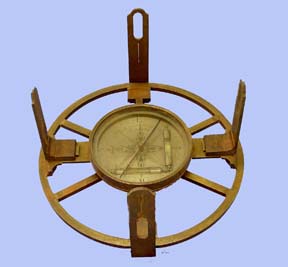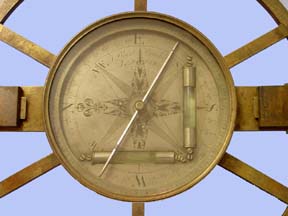 |
The instrument has a 5/16" thick outer graduated circular ring of 10 inches diameter. Mounting onto this ring are two 5.3-inch sight vanes that slide into dovetail slots located on the underneath side. Moving independently of the fixed ring is a concentric circumferentor with sighting arms. The overall length of the rotating circumferentor is 9.4", and the end of the north arm is divided with a 3-minute vernier that is used for reading horizontal angles in conjunction with the divided outer ring. All divisions on the instrument are cut by hand. The circumferentor has separate 4.4-inch sight vanes that are attached by sliding into dovetail slots located on top of the arm near the outer ends. The purpose of having two sets of sight vanes is to enables the surveyor to measure angles independent of the magnetic needle, hence its being called a theodolite. Inside the elaborately engraved 5-inch diameter compass box are two 2-inch spirit levels at right angles to one another. There is no needle arrestor. A conical staff mount is below the compass. Thomas Blunt (fl. 1760-1822) was at first apprenticed to Edward Nairne, and then he became his partner. The two were together at least as far back as 1775. The partnership broke up in 1793, though early 19th century instruments signed with both their names are reportedly known. "(Blunt)....was an instrument maker of distinction: he was associated with the Portuguese scientist J.H. de Magellan and devised some of the features of Magellan’s ‘New Barometer’..." (Goodison), as quoted from Ray Giordano’s The Antiquarian Scientist, Catalog 10. This was an important type of surveying instrument for 200 years beginning in the 17th century, dating to possibly 1606. Most were made in England. A good description and history of the instrument appears in the publication The Compleat Surveyor, published in 1982 by the Whipple Museum of the History of Science, Cambridge. There it is called a simple theodolite. The publication also contains an illustration of a similar instrument reprinted from G. Adams Geometrical and graphical essays, London, 1803. Adams treatise calls it a "common theodolite." The Whipple Museum has another publication, Catalog 1, Surveying, which shows and describes a number of these instruments from their own collection. Other writers call them by different names. It is simply called a theodolite in Leybourn’s The Compleat Surveyor, first published in 1653 and in Gibson’s Surveying which was first published in 1739. Flint’s Surveying, first published in 1804, encourages using a compass constructed with two indexes, one moveable and one fixed, with which one can ascertain the angle between two lines without reference to the bearing of the sides. Flint’s description fits this instrument. Most American surveyors probably considered it too large and cumbersome, opting instead for the French graphometer which had a similar operation except it was based upon a half-circle. The book Geomagnetic Instruments before 1900 by Anita McConnell (London, 1980) shows and describes two T. Blunt instruments. One is an early 19th century Variation Compass by Blunt, the other a Dip Circle by Nairne & Blunt, c. 1775. |




